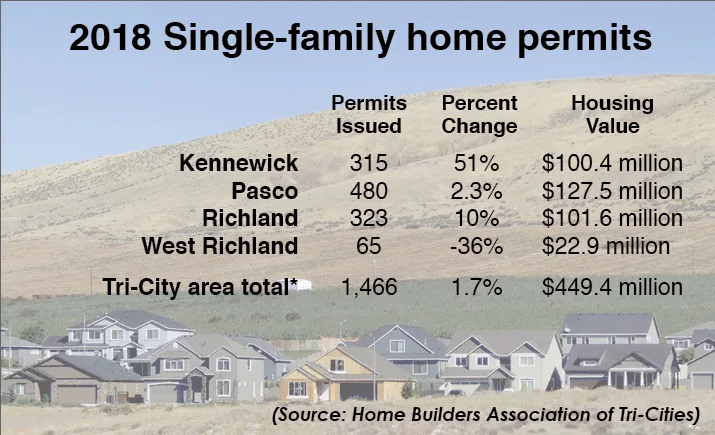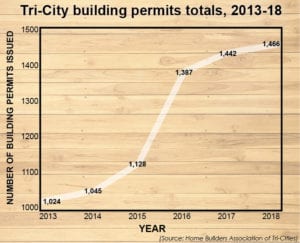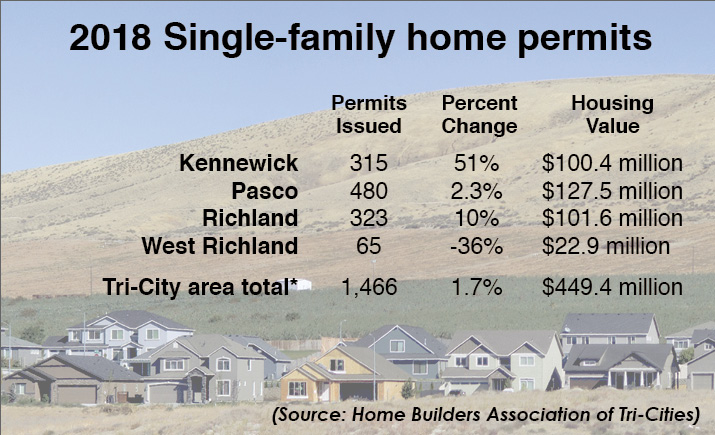
Home » Hot Tri-City housing market showing signs of slowing down
Hot Tri-City housing market showing signs of slowing down

January 14, 2019
The Tri-Cities’ red-hot housing market is beginning to show signs of cooling.
After a multi-year trend of rapidly appreciating home values, the construction labor force is stretched thin, interest rates are on the rise and building material prices are up due to new tariffs.
But that’s not to say new housing projects have ground to a halt. The residential home market trend continues to point up.
The number of single-family home permits issues in 2018 in Benton and Franklin counties increased 1.7 percent over the previous year to 1,466.
The modest percentage increase mirrors the trend from four years ago when year-over-year growth was 2 percent in 2014. The housing boom hit the area in 2016, with 23 percent growth over the previous year.
 The number of single-family home building permits issued (excluding manufactured homes) in 2018 in Benton and Franklin counties totaled more than $449 million in new construction, up from last year’s $421 million.
The number of single-family home building permits issued (excluding manufactured homes) in 2018 in Benton and Franklin counties totaled more than $449 million in new construction, up from last year’s $421 million.
An additional 133 manufactured homes permits were issued in 2018, valued at about $9 million.
The building permit data comes from the Home Builders Association of Tri-Cities, which tabulates the number of single-family home permits issued in the two counties.
“It was a positive year for 2018,” said Jeff Losey, HBA’s executive director.
Pasco once again led the four cities with 480 single-family home permits issued in 2018, a 2.3 percent increase over the previous year.
Many new lots continue to become available off Road 68 and Burden Boulevard, as well as Road 100, where Losey said the city of Pasco has “a lot of plans … in getting new properties inside the (Urban Growth Area) and developed.”
Pasco continues to generally be the least expensive and easiest of the four cities to put in homes, owing to its soil being very workable, Losey said. He said there’s more river rock on the south side of the river to contend with.
Kennewick recorded the biggest year-over-year growth in 2018 in home permits with a 51 percent increase over the previous year. That translates to 315 single-family home permits issued, with the majority of the new homes going up in the burgeoning Southridge area at the south end of the city.
Now that much of Southridge’s critical commercial infrastructure is in place, housing has quickly followed, with plentiful development opportunities along the Bob Olson Parkway and beyond, Losey said.
Richland recorded 323 single-family home permits last year, an uptick of 10 percent over the previous year.
Losey said the major growth area for Richland will continue to be the developing Badger Mountain South community.
West Richland was the only city of the four trending down in 2018, with 65 permits filed in 2018, versus 102 in 2017, a 36 percent decrease.
The number of single-family home permits dipped in unincorporated areas. Franklin County saw an 8.6 percent decrease, while Benton County saw a 39 percent decrease.
The general slowdown across the region compared to past years is due to multiple developing market pressures, Losey said.
“Everything has started to cool down just a little bit as interest rates started going up over 2018,” he said.
In addition, it’s become increasingly difficult for the construction sector to keep up with the relentless demand, Losey said.
“We currently have a shortage of construction workers and an aging work force,” he said.
The rising cost of land and building materials also have affected home prices across the Tri-Cities.
“Whatever the national mood is, the national mood does tend to affect us to a certain degree,” he said, adding that the rapid increase in Tri-City home values of the past few years was not a sustainable trend.
“Demand has remained the same as prices continued to rise,” he said, which has had the negative repercussion of potentially pricing some buyers out of the market. “If you’re buying and selling in the same market, it’s not much of an advantage.”
“The more homes that sell in hours rather than days and weeks makes the market too hot,” he said.
Losey views the cooldown as a good thing, “so that home prices don’t appreciate too fast.”
“Prices will still grow, but won’t grow at such a rate that will be unattainable for most people to keep up with those price increases,” he said.
The average price of Tri-City homes sold in 2018 was $294,900, according to data from the Tri-City Association of Realtors, up from the previous year’s average of $265,100, an 11 percent increase. The median home sale price last year was $275,000, up from $246,600 the previous year.
The total number of homes sold in 2018 totaled 4,427, up 23 homes from the previous year.
Despite the new challenges creeping up in the market, Losey pointed out that the number of single-family home permits filed in 2018 still surpassed the number filed each year for the past five years — from 1,024 in 2013, to 1,466 in 2018, is a 43 percent increase.
Looking ahead to 2019, Losey said he is “cautiously optimistic.”
“We’re seeing that, starting out in 2019, it’s a little flatter,” he said of single-family home permit filings.
He said based on the preliminary numbers, 2019 is starting off resembling 2017, which he explained might be another sign of the market leveling off.
“There are a lot of question marks surrounding the world economy,” Losey said. “We’re still not sure what’s going to happen with interest rates and how many more times they’re going to raise over 2019. But if 2019 continues like it did in 2018, then there certainly could be more interest rate hikes.”
Overall, though, Losey said he’s confident the market cooldown “should bode well for the entire Tri-Cities. With demand not exceeding supply, it will give the lots and the land the opportunity to catch up to what’s out there.”
Real Estate & Construction Local News
KEYWORDS january 2019






